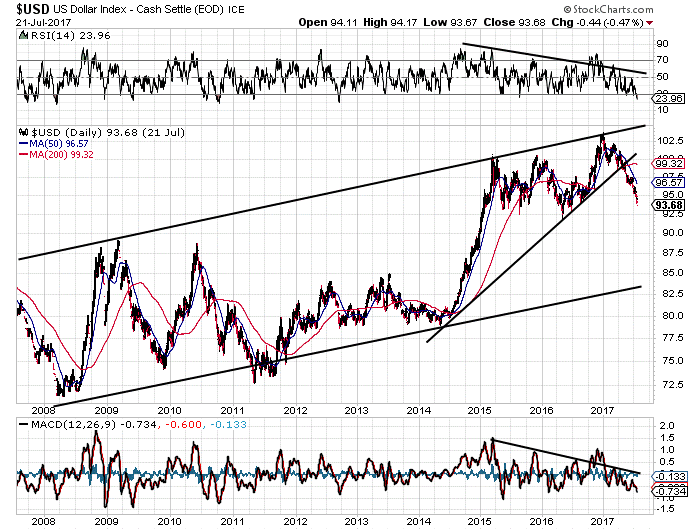The Future Looks Bad for the American Dollar
The U.S. dollar has been one of the worst-performing currencies in 2017, down nine percent year-to-date. Yes, despite the Federal Reserve raising interest rates three times since December 2016—and despite the central bank promising two more rate increases this year—the greenback is tanking. And it could get a lot worse for the world’s reserve currency.
Why have such a dire prediction on the dollar?
First, let’s look at its price action.
The chart below is of the U.S. dollar index, which tracks the performance of the dollar relative to other major world currencies. Pay attention to the lines drawn on the chart.
Also Read:
Will the U.S. Dollar Collapse in 2017?
Ominous Signs of the Coming U.S. Dollar Collapse Abound
Chart courtesy of StockCharts.com
As you can see, over the past five years, the U.S. dollar has been trading in a channel. In late 2016, it hit the top of the channel; since then, the currency has been falling.
Looking at the chart even closer, the dollar has been trading well below its 50-day moving average and 200-day moving average. These moving averages confirm that the long-term and short-term trends for the greenback are down.
Assuming that the dollar follows the channel in play since 2008, it could drop as low as 82. This would mean a decline of 12.4% from where the U.S. dollar currently sits, and more than a 20% decline from the highs made in late 2016. When an asset falls 20% from its peak, the asset is said to be in a bear market.
But charts are just one thing.
The U.S. dollar is the “reserve currency” of the world. That means most central banks hold U.S. dollars as their reserve currency. If the dollar continues to drop in value, will central banks still want it as a reserve currency? It’s an important question, because, if these central banks start selling U.S. dollars, the drop in the value of the greenback will accelerate.
For instance, the Chinese renminbi was recently added to the International Monetary Fund (IMF)’s Standard Drawing Rights (SDRs). In the first quarter of 2017, central banks held $88.54 billion worth of Chinese renminbi. That’s almost five percent higher than in the fourth quarter of 2016. (Source: “Currency Composition Of Official Foreign Exchange Reserves,” International Monetary Fund, last accessed July 23, 2017.)
Gold and the renminbi are alternative reserve currencies for central banks.
As I see it, 2017 could be a very bad year for the dollar. The price action is very clear: the trend is down for the U.S. dollar. And with more than half of S&P 500 companies getting their sales from outside the United States, a weak dollar puts downward pressure on their earnings and this overpriced stock market.







